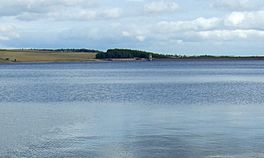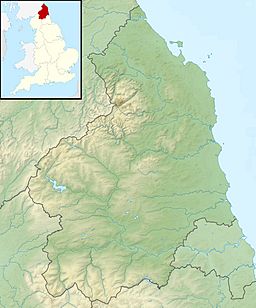Derwent Reservoir (North East England) facts for kids
Quick facts for kids Derwent Reservoir |
|
|---|---|

Derwent Reservoir
|
|
| Location | County Durham / Northumberland |
| Coordinates | 54°52′0″N 1°59′0″W / 54.86667°N 1.98333°W |
| Lake type | Reservoir |
| Primary inflows | River Derwent |
| Primary outflows | River Derwent |
| Basin countries | United Kingdom |
The Derwent Reservoir is a large, man-made lake in England. It sits right on the border between County Durham and Northumberland. This important reservoir helps supply drinking water to many homes in the north east of England. It is located west of a town called Consett. The reservoir is about 3.5 miles (5.6 km) long. It covers an area of 4 square kilometers. When full, it holds a huge amount of water: 11,000 million gallons!
Contents
Discovering Derwent Reservoir
Why Derwent Reservoir is Important
The Derwent Reservoir is a very important part of the water system in north east England. It is managed by a company called Northumbrian Water. This reservoir is the main source of water for the Tyne and Wear area. It supplies about 28 million gallons of water every single day!
How it was Built
People first suggested building the reservoir in 1957. Construction work began in 1960. The Derwent Reservoir was officially opened in July 1967 by Princess Alexandra.
Unlike many other reservoirs in northern England, Derwent Reservoir was built in a special way. Most reservoirs are made by flooding a valley and building a dam at one end. But Derwent Reservoir was actually dug out of the ground. The earth that was removed was then used to build its dam.
Water from Kielder
Sometimes, if the River Derwent needs more water, it can get extra water from a much larger reservoir. This larger reservoir is called Kielder Water in Northumberland. Water can be moved from Kielder to the River Derwent. However, this connection cannot be used to make the Derwent Reservoir itself deeper.
What's in the Water?
Scientists have found small amounts of certain metals in the mud at the bottom of the reservoir. These metals include zinc, lead, and cadmium. They came from old mining areas around a place called Blanchland. Because of these metals, there are not many large water plants growing in the reservoir.
Fun Activities at the Reservoir
Derwent Reservoir is not just for water supply; it's also a great place for fun activities! There is a sailing club here. This club hosts many events throughout the year. You can enjoy activities like windsurfing, sailing, running, and triathlons. The area around the reservoir is also famous for an annual bike race. This race is called the Tour of the Reservoir.
Making Electricity
The reservoir also has a special plant that makes electricity. This is called a hydro electric plant. It uses the power of water to create energy. The plant can produce 97 kilowatts of electricity.


